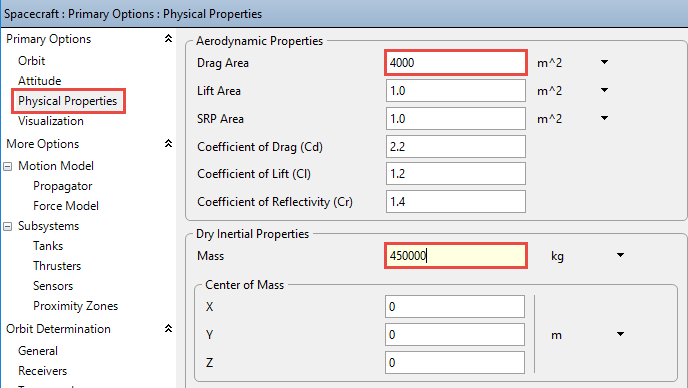Where does "space" officially begin? What is considered "inside the atmosphere"? A common standard is that "space" begins at a height of 100 km. However, this does not mean that there isn't any atmosphere above 100 km. There is actually a very small amount. It may be very miniscule, but it is enough to make a difference for LEO spacecraft over several years.
This small amount of atmosphere adds another force to be considered when modeling LEO spacecraft - Atmospheric Drag. The formula for this force is:
![]()
![]() = Force of Drag
= Force of Drag
![]() = Spacecraft coefficient of drag
= Spacecraft coefficient of drag
![]() = Frontal Area
= Frontal Area
![]() = Atmospheric Density
= Atmospheric Density
![]() = Relative velocity in reference to the object
= Relative velocity in reference to the object
The primary characteristic of this formula that you should pay attention to is that the force of drag is proportional to the frontal surface area. The bigger the spacecraft, the more drag force. So something like the International Space Station will feel a lot of drag.
However, if very large things feel a lot of drag, why isn't the ISS crashing into Earth as we speak? The answer is twofold. First, think about Newton's second law of motion. Just because one object feels more force than another does not mean that it will decelerate faster. Because the ISS is so massive (estimated 450,000 kg), the overall deceleration is very small. However, there still is definitely a noticeable deceleration of the ISS over long periods of time. The second reason the ISS isn't currently crashing into the Earth is because the ISS (like many other LEO spacecraft) will perform maneuvers to counteract the force of drag to stay in the same orbit.
Observing Atmospheric Perturbations
Problem: The International Space Station is in a Low Earth Orbit. ISS Crew Members gently release a CubeSat from the ISS, giving the CubeSat the same orbit. If neither spacecraft performs any maneuvers, which will re-enter the atmosphere first? The elements and characteristics for the spacecraft are as follows: |
|
ISS |
CubeSat |
A |
6775 km |
6775 km |
E |
0.001 |
0.001 |
I |
51.5 deg |
51.5 deg |
RAAN |
240 deg |
240 deg |
W |
65 deg |
65 deg |
TA |
0 deg |
0 deg |
Drag Area |
4000 m^2 |
0.01 m^2 |
Mass |
450,000 kg |
1.333 kg |
•Create a new Mission Plan and save it as "ISSCubeSatLifetime.MissionPlan"
Adding in Spacecraft
•Create a new Spacecraft and name it ISS
•Give the ISS the Keplerian elements listed in the table above
•Go into "Physical Properties" on the left-hand side
•Change the drag area to 4000 m^2
•Change the mass to 450,000 kg

Physical Properties Settings in the Spacecraft Editor
•Go into "Propagator" on the left-hand side
•Change the integrator type to "Bulirsch-Stoer VOP" (This will greatly improve the computation time)
•Go to "Force Model" on the left-hand side
•Change the atmospheric density model to "Jacchia Roberts" (This allows for more accurate drag calculations)

Atmosphere Models
•Click "Ok" to close the editor
Since most of the elements and characteristics are the same between the ISS and the CubeSat, it will be easiest to clone the ISS and adjust the necessary components.
•Clone the ISS by right-clicking it and clicking "Clone"
•Open the clone and rename it to "CubeSat"
•Go into "Physical Properties" on the left-hand side
•Change the drag area to 0.01 m^2
•Change the mass to 1.333 kg
•Click "Ok" to close the editor
Adding a PlotWindow
•Create a PlotWindow through the Object Browser
•Double-click "PlotWindow1" to open the editor
•For the "Y-Axis" drop down, change it to "ISS.Height"
•Click "More" to add another line to plot
•Change the new dropdown to "CubeSat.Height"
•Click "Ok" to close the editor
Building the Mission Sequence
•Drag and drop a "While...End" loop onto the Mission Sequence
•Change the while loop argument to "(ISS.ElapsedTime < TIMESPAN(600 days))"
•Drag and drop a FreeForm script editor inside the loop
•Change the name of the script to "Step, Update, and Check"
For this Mission Plan, we will assume that any Spacecraft below 170 km has officially "re-entered". Although many people consider 100 km to be the unofficial atmosphere/space boundary, the Spacecraft will drop very quickly after it has fallen below 170 km.
In this script, we will step both Spacecraft with an epoch sync, update the plot, and check to see if either of the Spacecraft are below 170 km. Once a Spacecraft falls below 170 km, we can stop the program entirely. To do this, we write:
// Step both Spacecraft with an epoch sync Step ISS; Step CubeSat to (CubeSat.Epoch == ISS.Epoch);
Update PlotWindow1;
// Checks to see if either Spacecraft gets too low If(ISS.Height < 170 or CubeSat.Height < 170) then; Stop; End; |
Your Mission Sequence should look something like this:

Mission Sequence Example
The Mission Sequence is complete! Before you run your Mission Plan, please note that this may take a while to run. Run your mission plan, then try and answer these questions:
Which Spacecraft re-entered first?
About how long did it take for the first Spacecraft to re-enter?